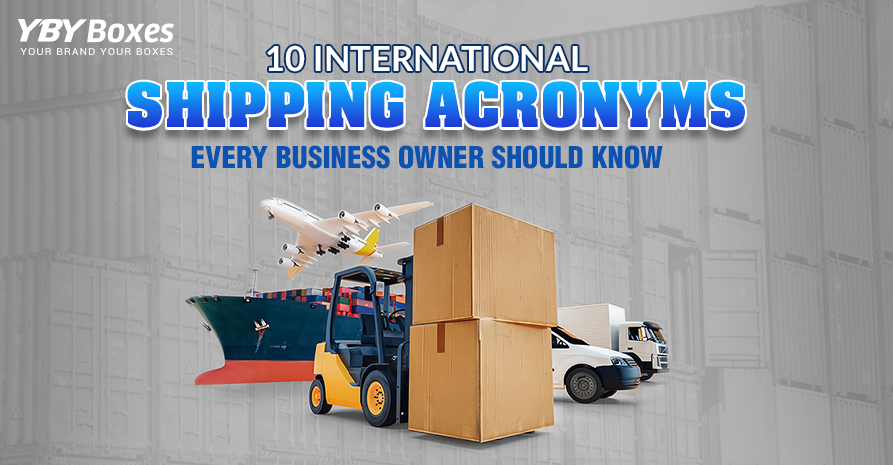-
Call Now:
888-800-8032

Shipping products seems simple and you may have an idea of how to ship various products or custom-printed boxes internationally but did you know there are different types of shipping acronyms? Having a complete knowledge and understanding of shipping terminologies is essential for any business.
It allows you to manage your shipments and ensure everything goes as planned efficiently. Let’s take a closer look at 10 of the most important international shipping acronyms used in shipping and what they mean. Keep reading!
It is abbreviated as free on board. FOB is one of the used internal shipping acronyms that is related to the supply chain process in which the buyer and seller become liable for the goods being transferred from one place to another. Once the goods cross the ship’s rail, the liability transfers to the buyer, who bears all the expenses thereafter.
Usage: It is commonly used when products are being shipped through inland water transport.
Carriage paid to is the full form of CPT. In this, the seller is responsible for all the risks/ costs linked with transporting the goods to the named destination place. Once the shipment is transferred to the named place of destination, the risk ultimately transfers to the buyer as soon as the goods are handed over to the first carrier.
Usage: It can be used for any transport mode.
Cost, insurance, and freight refers to when the seller covers goods cost, insurance, and freight expenses up to the destination port. Once the shipment is loaded on board the ship, risk ultimately transfers to the buyer and afterwards buyer will be responsible.
Usage: If you are a buyer and want simple cost when importing from another foreign country without indulging yourselves in insurance matters.
DAP means delivered at place. It refers to the arrangement wherein the seller covers all the costs/ expenses and is eligible to take the risk to move the products to the buyer’s location. In this arrangement, the seller is responsible for the payment and goods until products unload at the named place of destination.
Usage: It is normally used when you want to handle all transportation costs and risks to the seller until the specified place.
You can say free alongside ship is opposite to DAP. It is the agreement wherein the seller places the goods alongside the ship at the named shipment port. Afterward, the buyer is responsible for all the costs, risks, or damages to the goods from that moment.
Usage: It is often used where the buyer has direct access to the bulk cargo.
LCL means less than container load and it is often used by shippers who do not have enough goods to fill standard containers. Instead of waiting to accumulate enough goods to fill standard containers, they usually go for the LCL shipping method, allowing them to ship their goods in a shared container with cargo from other shippers.
Usage: This type of shipment can be normally used for smaller shipments as you have to only page for the space you use.
ETA indicates the date and time when your shipment is expected to arrive at a specific location. It is important for planning and logistics which ultimately help businesses prepare for receiving goods and manage inventory timely without any hassle.
Usage: It should be used by warehouse managers to customer service teams to streamline the coordination process.
General Rate Increase means the periodic rates increases due to some of the following reasons:
Usage: It is commonly used in the ocean freight industry to understand financial logistics planning and budgeting.
The purpose of a bill of lading is to acknowledge cargo receipt for shipment and this critical document is issued by the carrier. This document serves various roles like a contractual agreement between a shipper and freight carrier, a document of title, and a receipt of goods.
Usage: it is normally used for all modes of transportation especially in sea freight and includes all the necessary details that you want when goods being shipped from one place to another.
Proof of delivery is the last international shipping acronym that is used to ensure that the recipient has received their goods on time. It acts as a key indicator for the fulfillment of the delivery obligations by the carrier and acceptance verification by the consignee that they receive goods.
Usage: This document can be used for all modes of international shipping to resolve disputes and also acts as a confirmation tool.
All the international shipping acronyms that we mentioned above play an immersive role in managing your international shipments timely and accurate. From FOB, CPT, and CIF to POD, we provided a thorough overview of the latest shipping acronyms that every business owner should know to improve international shipping and logistics for efficient shipment. Also, with these acronyms, you can get an idea of where you can use these acronyms during international trade to manage everything on time.